
Philip is coming to understand that in flyfishing, waiting can be necessary – and also very productive.
“The walk will be worth it!” I promised JD as we descended a long, steep slope to the sound (if not the sight) of the river far below.
After a few leisurely sessions on other streams in the vast Goulburn catchment, we’d set this day aside for a genuine backcountry session.
Backcountry gamble
Backcountry fishing is usually a bit of a gamble. By definition, you can’t do a little ‘taste test’ by the roadside, just to be sure you’re making the right decision. To add to the tension, on this occasion, the location was my call – and it was made following a couple of very successful choices by JD the previous day.
Now, I should say that JD is the last person to attribute blame for choosing the wrong spot, so any pressure was entirely of my own making. But still, I was striding a little faster as we hit the small river flat, then pushed through the final few metres of tea-tree to the noisy water.
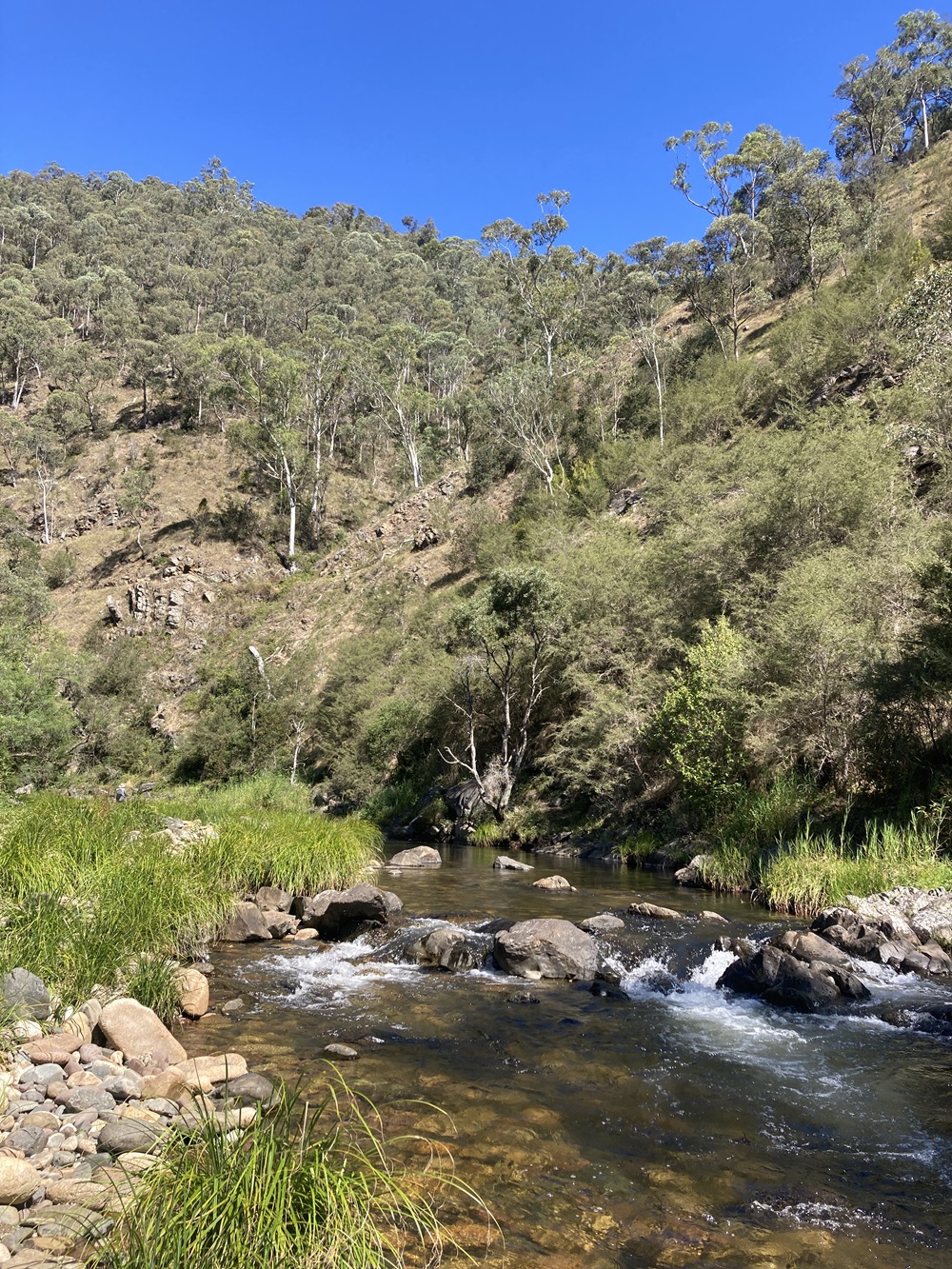
It looked good, very good in fact. Phew! While the flow was somewhat less than I expected, it was glass-clear. I fully expected to see a fleeing shape as I peered over the edge of a flood-worn boulder and into the sunlit depths. No sighting, but that didn’t mean much. As I so often need to remind myself, trout are designed not to be seen, so no result from one random glance was of little consequence.
Still full of start-of-the-day enthusiasm, we decided to split up for half an hour. JD would fish straight upstream, while I would bush-bash down a couple of hundred metres and fish back up. Then we would meet up, compare notes, and thereby (hopefully) come up with a somewhat more informed plan for the rest of the day.
My downstream push was itself a process. Every time I thought I’d left myself enough water, I’d peek through the scrub, only to notice that the river downstream looked even better. This is how missed rendezvous happen: ‘just one more pool’ syndrome doesn’t only apply to the end of the day.
So I took a breath, and walked right into the river at the top of a beguiling run. Oh well, I reasoned, there’s never going to be a harmless place to enter a decent stream.
Slow start
My entry point placed me just below the tail-out of the small pool above, while sacrificing the run downstream. Like I say, some streams simply don’t have an entry option that’s guaranteed not to spook fish. Still, the tail-out was a likely place for a trout to hold, so I tied on a small Royal Wulff with a hot dot PTN about a metre beneath, and I did my best to get a couple of short, drag-free drifts while staying low and out of sight. Nothing happened, and I reminded myself that first or second cast trout are regarded as a bit of curse among many of my fishing mates. Lake or stream, we reckon such an early result can prove too good to be true. While I can’t give you any hard data, if a few of us have got to the point of linking instant success with a tough day subsequently, maybe there’s something to it. Or more likely, that’s just a self-fulfilling prophecy at work.
In any case, I wasn’t at all put out by the early lack of action (and I allowed that maybe I did get drag that I hadn’t notice). My focus was soon on the head of the pool, a classic hotspot where the rapid above tumbled into over a metre’s depth of bedrock-lined current. I was about to make the obvious cast, when I noticed a much less significant side current emerging from under a flood-bashed tea-tree on my right. I managed to cast the dry/dropper in underneath it, and as the flies drifted out, a 14 inch brown was in hot pursuit of the nymph. It caught up just in time, and I soon had my first trout of the day.
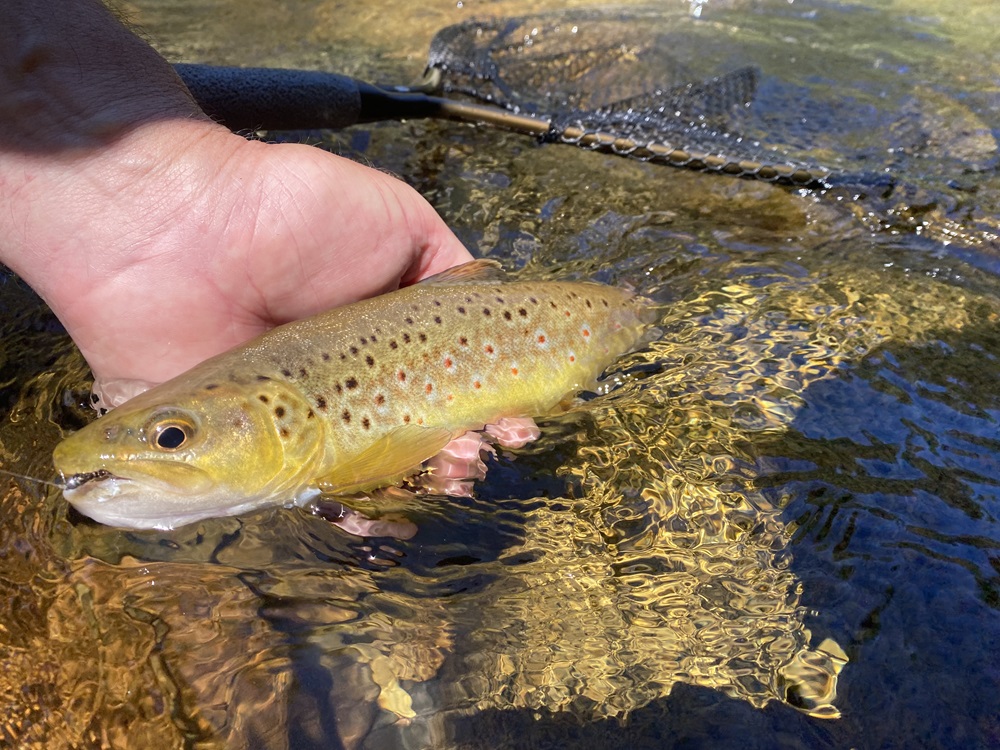
The good-looking head of the pool just above produced nothing, but I reasoned that the struggles of my brownie might have spooked it.
The next pool looked like fly heaven; a long cast from one end to the other, roughly thigh deep, with sword-grass and undercuts on the left bank, boulders on the right. There was enough current to stop my bow-waves pushing up if I moved carefully, and to form a neat bubble-line. I fished with careful anticipation, but by the time I finished the pool, the only sign of a fish had been one small rainbow nudging the Royal Wulff.
I was just about to start on the next stretch of water when I saw JD walking down the bank towards me. Sure enough, a glance at my phone revealed that surprisingly, over 30 minutes had already passed. From a distance, I offered a curious ‘get any?’ shrug. The reply was a clinical thumbs down. Oh.
Once JD got close enough for a normal conversation above the sound of the river, he confirmed he’d had no action. None. “Would have expected to at least see a couple spook or something,” he commented evenly, “The water is so clear!” For a troubling moment, I thought he was going to suggest we head straight back up the mountainside and out. But no. The consensus was half an hour – even half an hour each – wasn’t enough for a proper assessment. And at least I had caught a reasonable fish, so it wasn’t a complete disaster.
We wandered back up to where JD had finished. We agreed he would restart there, while I’d cut across the bend and start just below an obvious rockface up ahead.
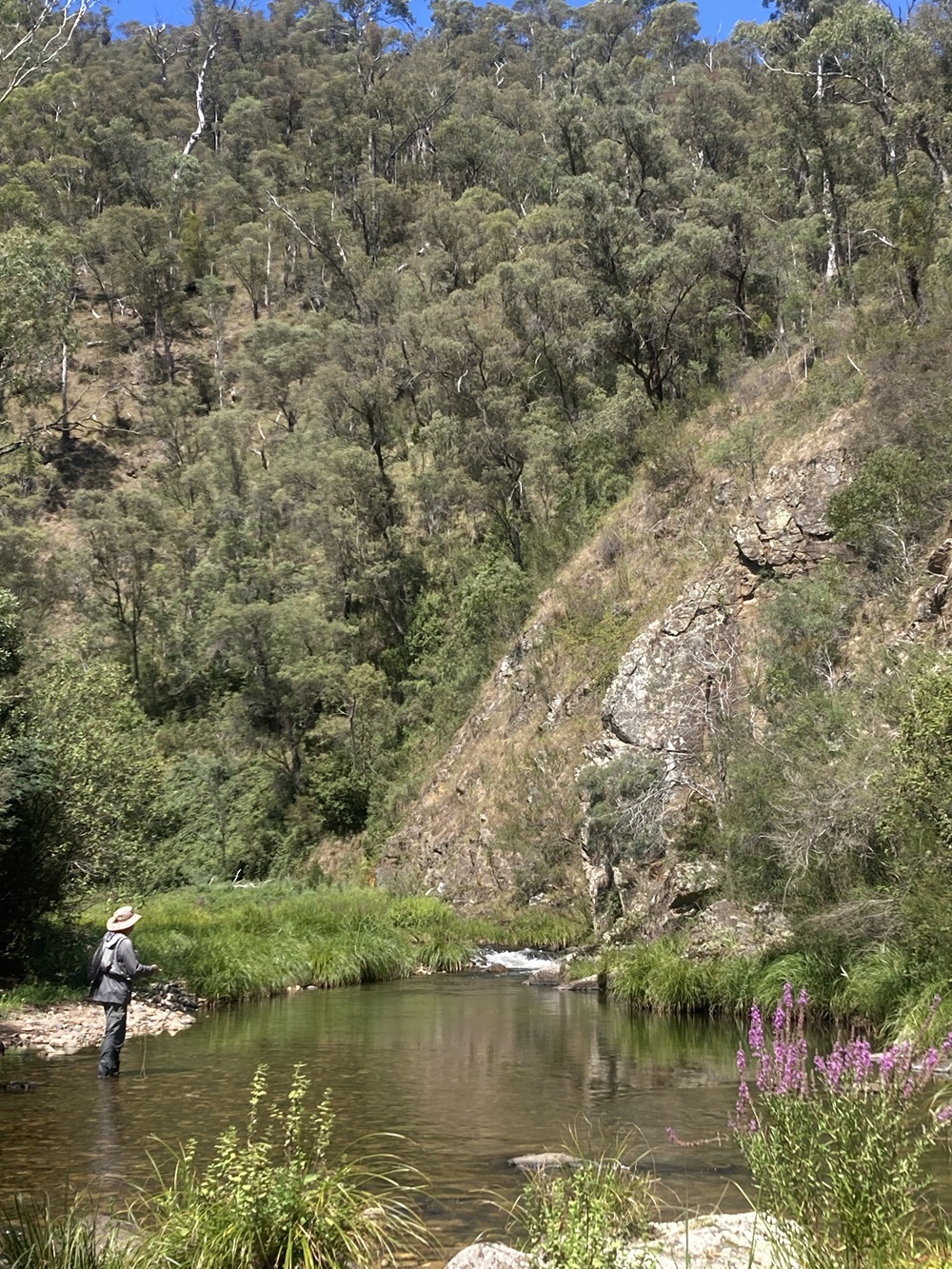
Getting better?
As I approached my new stretch through a shady grove of wattles, I had a good view of the river below… and two, no three different trout swimming around in the broad shallow tail. I assumed I was invisible from my shaded perch above the sunlit water, yet apparently not. As I stepped down the bank to make a cast, all three fish accelerated towards the somewhat deeper water on the far bank. Oh well, at least they’re there!
Giving up on the spooked trout, I waded carefully into the tail, half aware of JD a hundred metres downstream, reaching for something I couldn’t see behind a sword-grass island. Fish or snag? I didn’t find out, because just then, I heard the splash of a rise up ahead. The river was now wider and meandering; half run, half shallow pool. Lots of possibilities, but no standout section. Remotivated by the presence of the trout I’d seen a few minutes earlier, I fished the water carefully instead of racing straight to the rise. Then, from out of nowhere, a good brown rose up for the Wulff. I missed it, but two casts later, about where the initial rise was, the Wulff went down and I was hooked up to a solid rainbow on the nymph. JD arrived just as I was reaching for the net. My triumphant lifting up of the fish was met with, “Nice!”, followed by a nonchalant, “Got two down there.”
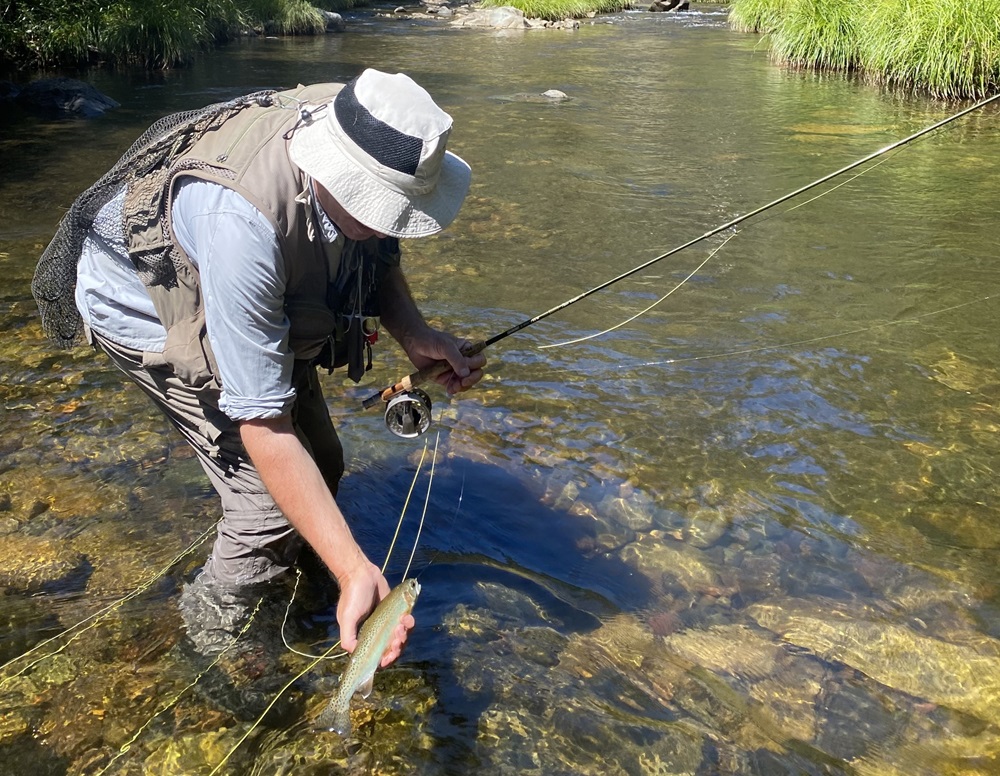
Best
Those few minutes marked a turning point. We were learning that, for whatever reason, the trout weren’t really in the deeper, more classically-defined pools and runs. (Or if they were, we hardly saw them.) Instead, we found them spread out through the shallower, faster water – often in places you’d usually not bother with. So much so that, even as we learned to treat every boulder, tiny depression or side runnel with care, we still virtually trod on several good fish.
As the day wore on, it almost became a game to see who could pull a trout from the most unlikely spot. I think JD might have won when he caught a brownie of close to two pounds from a little anabranch trickling through the sword-grass which we almost walked straight past without noticing.
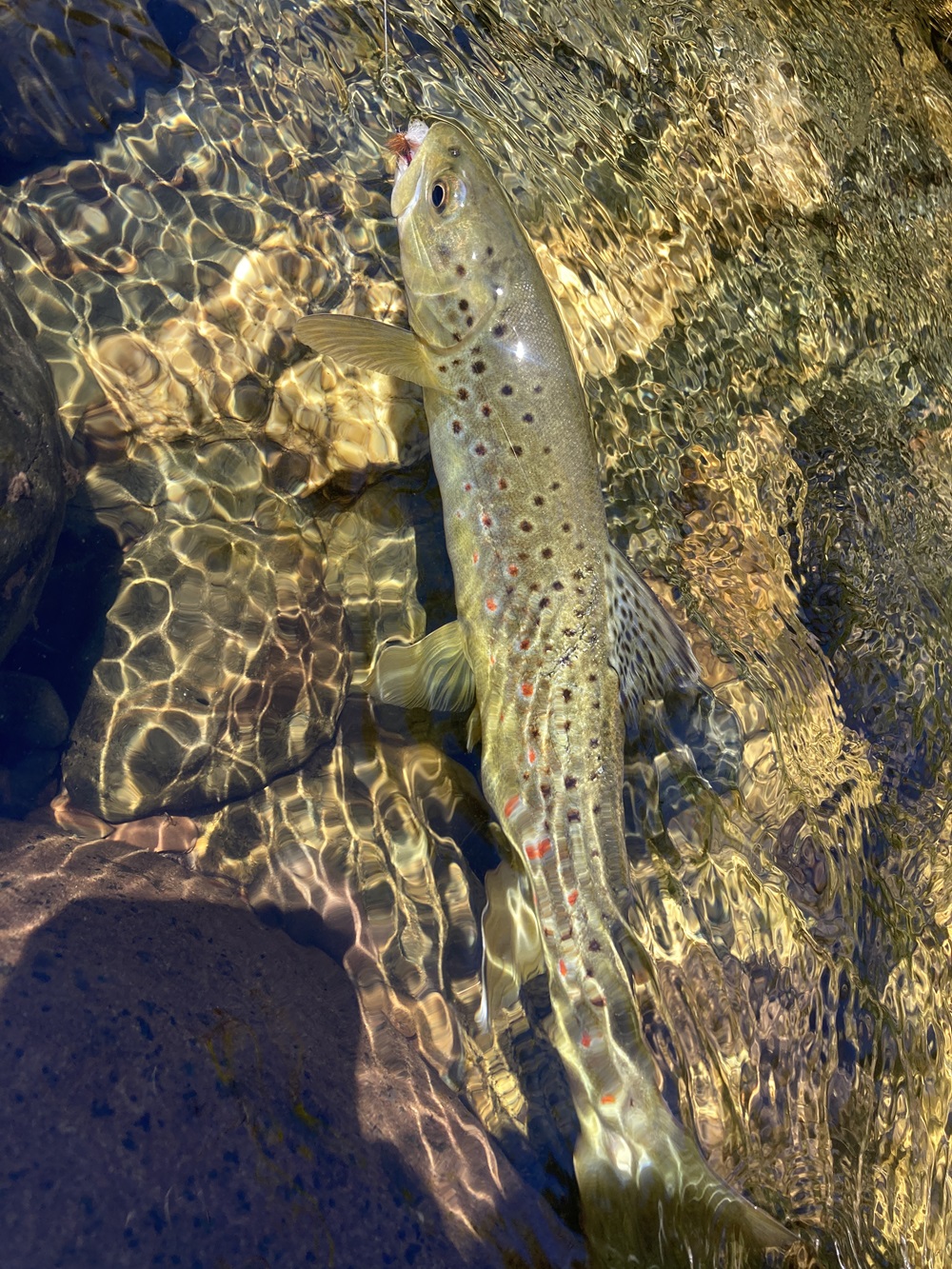
Give them time
We ended up having a fantastic several hours of fishing, which will probably make it into the ‘remember when?’ club. But what struck me later was, it was yet another notable day in recent months which had begun with very little promise. For example, during a trip to Tasmania a few weeks earlier, it was virtually a given that no good day began well. On that trip, a mutual friend observed that you should never write off a location based upon the first hour of fishing. How true that turned out to be. Whether it was Dee Lagoon, Bronte, Binney… you name it, a slow start was common – and rarely a harbinger of a bad day. Either it took time to find the fish, or the fish took time to get going.
It occurred to me on both the JD backcountry trip at the end of February, and the Tassie highlands one at the start of it, that I can be a slow learner. I wince at the thought of the dozens of times over the years I’ve been to Tasmania, and on the first half-decent weather day, my mates and I spent more time charging around the highlands in a car than actually fishing. One thing’s for certain – you can’t catch a fish if you’re not actually fishing. Typically, we would screech to a halt, race along a lake shore for a hundred metres, decide we could do better, and disappear in a cloud of dust towards the next spot.
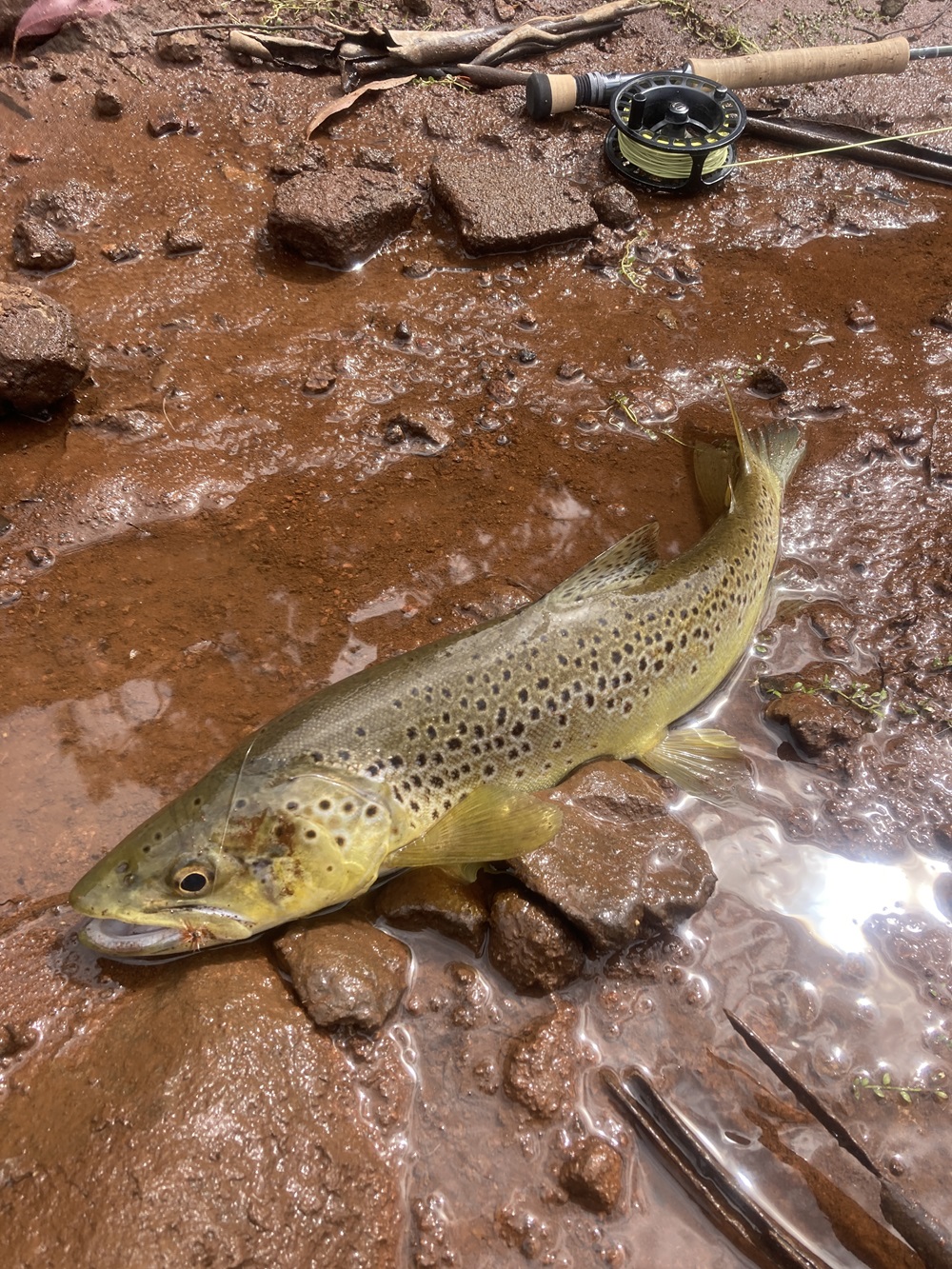
When I initially started going to New Zealand nearly 30 years ago, I remember being a little frustrated at the way the guides would stick with a river when (to me) it was looking pretty hopeless. One hour in … 2 hours… not even a fish sighted. I’d be thinking, why don’t we just cut our losses and drive to a better stream while there’s still time? But of course, almost always, the guide would hold their nerve, and for good reason. I was lucky enough to fish with a seasoned New Zealand visitor (Felix Borenstein, who would later go on to create Owen River Lodge) who in turn used very capable guides. These guides made their daily location decisions based on a lot of long-term experience, reinforced by regular recent visits. In other words, the fundamentals stacked up, so barring some unforeseeable disaster, they knew the fishing would come good sooner or later – and it always did.
This may be one reason I love flyfishing so much. There simply isn’t an end point you get to and think, ‘Right, I’ve got all that sorted.’ You might become an expert on flies, or hatches, or drag-free presentations – you name it. However, sometimes all you have to do; or more to the point, what you need to do, is give a spot time.











